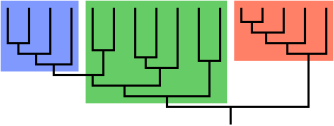Clade
A clade (from др.-греч. κλάδος, klados, "branch") or monophylum (see monophyletic) is a life-form group consisting of an ancestor and all its descendants—representing a single "branch" on the "tree of life".[1] The ancestor may be an individual, a population or even a species (extinct or extant).
Many commonly named groups are clades, for example, rodents, or insects; because in each case, their name comprises a common ancestor with all its descendant branches. But, the commonly named "lizards" is not a clade, and neither is "monkeys"; in each case, the last common ancestor has one or more descendants that are excluded from the meaning of the name—that is, the common name "lizards" excludes snakes; "monkeys" excludes apes and humans.
Increasingly, taxonomists try to avoid naming taxa that are not clades.

Etymology
editThe term "clade" was coined in 1957 by the biologist Julian Huxley to refer to the result of cladogenesis, a concept Huxley borrowed from Bernhard Rensch.[1][2]
Definitions
editClade and ancestor
editA clade is by definition monophyletic, meaning it contains one ancestor (which can be an organism, a population, or a species) and all its descendants.[note 1][3][4] The ancestor can be known or unknown; any and all members of a clade can be extant or extinct.
Clades and phylogenetic trees
editThe science that tries to reconstruct phylogenetic trees and thus discover clades is called phylogenetics or cladistics, the latter term being derived from "clade" by Ernst Mayr (1965). The results of phylogenetic/cladistic analyses are tree-shaped diagrams called cladograms; they, and all their branches, are phylogenetic hypotheses.[5]
Three methods of defining clades are featured in phylogenetic nomenclature: node-, stem-, and apomorphy-based (see here for detailed definitions).
Terminology
editThe relationship between clades can be described in several ways:
- A clade located within a clade is said to be nested within that clade. In the diagram, the hominoid clade, the apes and humans, is nested within the primate clade.
- Two clades are sisters if they have an immediate common ancestor. In the diagram, lemurs and lorises are sister clades.
- A clade A is basal to a clade B if A branches off the lineage leading to B before the first branch leading only to members of B. In the diagram to the right, the strepsirrhine clade, including the lemurs and lorises, is basal to the hominoids, the apes and humans. Some authors have used "basal" differently, using it to mean a clade that is "more primitive" or less species-rich than its sister clade; others consider this usage to be incorrect.[6]
Nomenclature and taxonomy
editThe idea of a clade did not exist in pre-Darwinian Linnaean taxonomy, which was based by necessity only on internal or external morphological similarities between organisms – although as it happens, many of the better known animal groups in Linnaeus' original Systema Naturae (notably among the vertebrate groups) do represent clades. The phenomenon of convergent evolution is however responsible for many cases where there are misleading similarities in the morphology of groups that evolved from different lineages.
With the publication of Darwin's theory of evolution in 1859, the idea was born that groups used in a system of classification should represent branches on the evolutionary tree of life. In the century and a half since then, taxonomists have increasingly worked to make the taxonomic system reflect evolution. When it comes to naming, however, this principle is not always compatible with the traditional rank-based nomenclature. In the latter, only taxa associated with a rank can be named, yet there are not enough ranks to name a long series of nested clades; also, taxon names cannot be defined in a way that guarantees them to refer to clades. For these and other reasons, phylogenetic nomenclature has been developed; it is still controversial.
See also
editCultural references
editClade is the title of a novel by James Bradley, who chose it both because of its biological meaning but also because of the larger implications of the word.[7]
Notes
editReferences
edit- ^ a b Dupuis, Claude (1984). "Willi Hennig's impact on taxonomic thought". Annual Review of Ecology and Systematics. 15: 1–24. doi:10.1146/annurev.es.15.110184.000245.
- ^ Huxley, J. S. (1957). "The three types of evolutionary process". Nature. 180: 454–455. doi:10.1038/180454a0.
- ^ "International Code of Phylogenetic Nomenclature. Version 4c. Chapter I. Taxa". 2010. Retrieved 22 September 2012.
- ^ Envall, Mats (2008). "On the difference between mono-, holo-, and paraphyletic groups: a consistent distinction of process and pattern". Biological Journal of the Linnean Society. 94: 217. doi:10.1111/j.1095-8312.2008.00984.x.
- ^ Nixon, Kevin C.; Carpenter, James M. (1 September 2000). "On the Other "Phylogenetic Systematics"". Cladistics. 16 (3): 298–318. doi:10.1111/j.1096-0031.2000.tb00285.x.
- ^ Lua error in package.lua at line 80: module 'Module:Citation/CS1/Suggestions' not found.
- ^ "Choosing the Book title 'Clade'". Penguin Group Australia. 2015. Retrieved 20 January 2015.
External links
edit- Evolving Thoughts: Clade
- DM Hillis, D Zwickl & R Gutell. "Tree of life". An unrooted cladogram depicting around 3000 species.
- Phylogenetic systematics, an introductory slide-show on evolutionary trees University of California, Berkeley